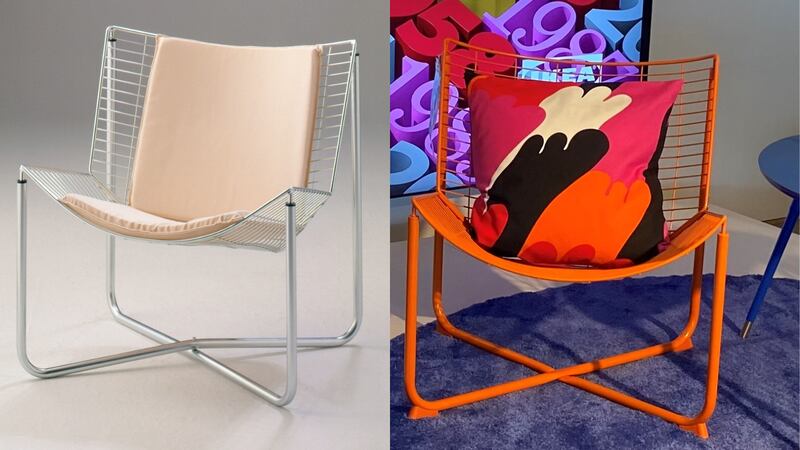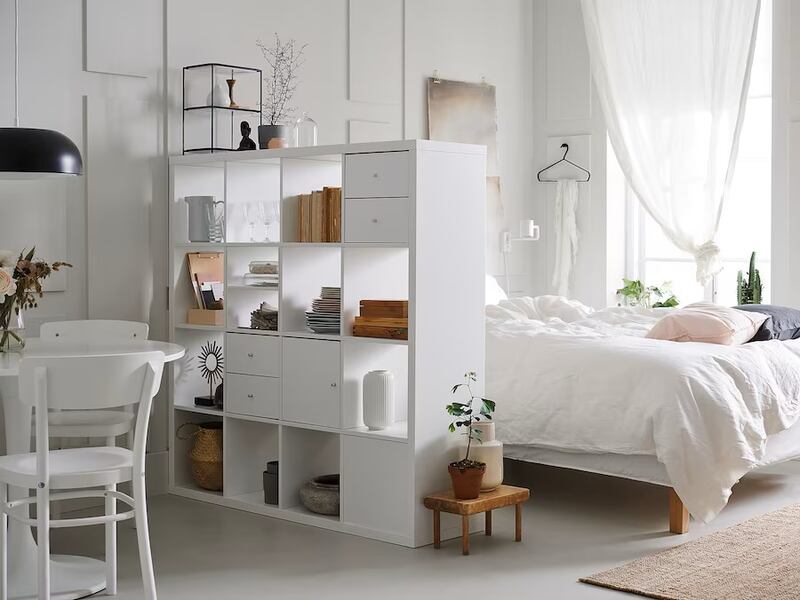What do you do after you’ve designed award-winning modern furniture classics for Ikea? If you are Niels Gammelgaard, you go around flea markets in Sweden buying your work. “Ikea have sold about half the furniture in Sweden since the 1950s, so when I go to a flea market I buy them,” he says. “Because I was working mainly in steel and good plastic – polypropylene – it lasts forever so still they look like new.”
Irish consumers won’t have to go to Swedish flea markets to get their hands on some of his designs, as they are part of a new collection of classics being released by Ikea in stages, starting this month.
The Swedish flatpack giant is travelling back to the future as it marks 80 years in business by trawling through its archive. It is reproducing some celebrated designs with a contemporary twist and using more sustainable materials where possible.

Niels Gammelgaard worked with Ikea for 30 years and designed the Jarpen chair in 1980 when Ikea founder Ingvar Kamprad asked him to make the world’s cheapest lounge chair. To achieve that, he went to factories that made supermarket trolleys and came up with the steel mesh chair that cost the equivalent of €10. After it appeared in the Ikea catalogue in 1983, it sold at a rate of 4,000 per week.
READ MORE
One website is currently selling one of the chairs for €650. The modern version of the Jarpen chair will arrive in stores in October and, while the price has not yet been fixed, it will be a bit higher than €10 but definitely well below €650.

Vintage Ikea pieces are increasingly sought after, according to Karin Gustavsson, the creative leader of this new collection, called Nytillverkad. In 2021, Ikea’s Cavelli armchair, designed by Bengt Ruda, sold at auction for 151,000 Swedish kroner (more than €12,800).
Of course, all the vintage-inspired pieces in this collection will be new to Irish customers as Ikea only arrived in the Republic in 2009. “There are so many countries that have never seen old Ikea catalogues, so when we decided to redesign some of our oldies, it got so much attention, especially among the young ones,” Gustavsson says.
Among the oldest designs is the Lövet side table, first introduced in 1956. Now called Lövbacken, it comes in orange, blue, and light green with an ash veneer top. They’ve also brought back the pine Jerry (renamed Domsten) stool which was very modern when it was released in 1977.
“There is a revival in pine, which is interesting to see as pine often went to the summer houses or the second-hand market and now everyone is screaming for pine furniture again,” she says. Like all the pieces, the new stool comes in a selection of bright and playful colours. Ikea global design manager Johan Ejdemo says there is a strong demand for more colourful and fun designs.
‘Find joy’
“The need for optimism in these times is very much evident and these playful and colourful, optimistic approaches to our products are appreciated,” he says. “There is a need to find joy in everything in these difficult times.” He has worked with Ikea for 25 years and has noticed how the demand for making the most out of small living spaces has increased significantly. “Small-space living is one of our long-term priorities, so we always look at the products through that lens.”
But how difficult is it to marry the increasing drive to be more sustainable with producing affordable products that are aesthetically pleasing? He says it’s a positive thing because it encourages creativity. “Having the scale and the volumes that we have is enabling us to lead the change on sustainability,” he says. “Just because you have a small budget shouldn’t stop you from making sustainable purchases.”

Ikea has often been accused of encouraging consumer spending on unnecessary items, but he says the company makes products that last, and cannot be blamed if customers use them in an unsustainable way. For example, Ikea sells a tempered glass dinner plate for €1, and plastic plates for even less, which would suit people on a very limited budget. “If someone else buys those plates to throw a big party and then throw them away, well, that’s not why we produced these plates,” he says.
Ikea aims to be climate positive by 2030, which means reducing more greenhouse gases than it emits. That’s a big ask for a homewares business that has more than 460 stores in 62 markets and fed more than 700 million people last year. That explains the extension of the meatball range to include veggie and plant balls but there’s still a long way to go. More than 40 per cent of its plastic products are now based on recycled and renewable materials and that has to reach 100 per cent by 2030.
Its Buyback and Sell service allows people to sell back certain Ikea products and they can be resold in the stores’ Circular Hubs. Swedish customer Bengt Johansson really tested the scheme in 2021 when he returned a bookcase he had purchased in 1965, still in perfect condition, along with the handwritten paper receipt. Here in Ireland, almost 4,000 items have been sold back, mostly chests of drawers, storage units and shelving.

Of course, Ikea founder Ingvar Kamprad was sustainable long before the word was associated with the environment. Famed for his thriftiness, the billionaire drove his Volvo 245 for more than 20 years and never saw the need to fly business class. When he once took a cruise, he discovered that he had to pay for water but ice was free, so he took to ordering glasses of ice.
Ikea’s museum at its design headquarters in Älmhult in southern Sweden has many examples of his thrifty use of materials. The Klint chair is on display to remind visitors that when Kamprad visited a factory making the chair seat he realised that, if the seat was one centimetre smaller, three covers could be made from one roll of fabric instead of two.
When old porcelain fuse boxes were being replaced in the 1990s, Ikea started using the machines and know-how in the fuse box factories to produce tealight holders.
Ikea catalogue
Some 155,516 people visited the museum last year, an indicator of the special place Ikea has in the hearts of Swedish people. The Ikea catalogue – which was discontinued in 2021 for environmental reasons – was so popular that many Swedish letterboxes carried the badges “No advertising or junk mail please, just the Ikea catalogue.”
The museum is on the site of the first Ikea store, opened in 1958 in what was then a sleepy village. Today, 5,600 people work there in a cluster of Ikea buildings in areas such as product development and testing. One lab is burning candles to check for stability while another is sending a 120kg roller across a mattress for hours on end to see how it responds.
Happily, there’s no need to panic if Ikea workers miss the last train home. They can rest their weary heads on an Ikea pillow in the world’s only Ikea hotel across the street.
And no, they won’t have to assemble the bed first.
What the Irish buy in Ikea
We might not like being stereotyped as a nation of heavy drinkers, but if Ikea’s sales are any indicator, we are still enthusiastic pint drinkers.
In the last financial year, its flagship store in Dublin’s Ballymun sold the most Lodrät pint glasses worldwide – almost three times more than the number two store.
Ikea’s Irish customers broke a few other records last year, according to Marsha Smith, deputy country manager for the UK and Ireland.
Ikea Dublin was the number one store in the world when it came to cooking and eating accessories, and is the world’s number one store for children’s department sales – this is total sales, not adjusted for population size. The Dublin store sells the most Måla children art supplies of any other store globally. “Ikea Dublin was also the number one store in home decoration sales, with no other store selling as many frames,” she says.

Based on customer demand, Irish interior design trends involve earthy colour palettes, curved lines and natural materials. “Storage is always a huge issue in Irish homes – never enough space. we want less stuff and more storage space,” she says. Ikea is now rebuilding its bedroom and children’s department in the Ballymun store, to offer solutions to the storage and living challenges raised by its Irish customers.
One of those challenges involves finding space for sports equipment. She has lived in Canada, Ireland and the UK and says she really noticed the focus on year-round sporting activities here. “Sports are not as varied in some of the homes in the UK. One of my first revelations when I moved to Ireland with my two children was the vast array of sports that you do, and how much time is dedicated to sport, which is quite different to the UK.”
Ikea now has shops offering planning and ordering services in Naas, St Stephen’s Green, Drogheda and Cork but she says the opening of the customer distribution centre in Rathcoole in Dublin early next year will be a milestone for Irish customers.
It is expected to cut online delivery lead times by more than half. “The route that the goods currently take is not an easy one and we always wanted to get to the point where we were really in control of fulfilling orders. Online has grown so much this year and we need to offer a service where we can get the goods to customers at the earliest opportunity,” she says.





















